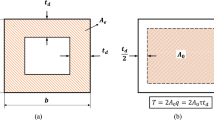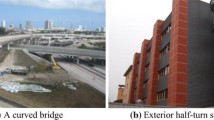Abstract
The study of torsion in reinforced concrete members began in the early twentieth century but it has become more widespread in the past 60 years. Even today, this topic has not been deeply researched with respect to slabs. This work reports a study on the behavior of reinforced concrete slabs subjected to torsion, with particular attention to the stiffness in state I and state II (uncracked and cracked phase) and to the relation T–θ (torsional moment-twist). It is known that torsional forces lead to a much larger loss of stiffness in state II, due to the strong cracking, than the loss of flexural stiffness. When the member is predominantly subjected to bending moments the K I/K II ≈ 3–5 is usually admitted, but when torsion has a preponderant role this relationship is not valid. This study may alert the scientific community to a seemingly unknown relation: torsional stiffness of reinforced concrete slabs, in the cracked phase, is about 1/17–1/15 of the stiffness in the elastic phase. For the analysis of slab deformation, particularly under service conditions, accurate knowledge of the slab stiffness in state II is important. The knowledge of T–θ relation is also important to perform a numerical nonlinear analysis. An experimental program was designed and carried out in which 9 slabs were tested until failure. To submit the slabs predominantly to torsional moments, vertical movement at 3 corners was restricted and the action was applied to the fourth corner. Based on the results obtained, the following relations were defined: load–displacement (P–d), torsional moment-twist (T–θ) and K T,I/K T,II.








Similar content being viewed by others
Abbreviations
- d :
-
Vertical displacement
- \( f_{\text{c}}^{\prime } \) :
-
Concrete compressive strength
- f cm :
-
Average concrete compressive strength
- h :
-
Wall thickness of the hollow section
- m xu :
-
Flexural resistance in the x direction
- m yu :
-
Flexural resistance in the y direction
- m x , m y :
-
Flexural design moments in the reinforcement directions (x and y)
- m xy :
-
Torsional design moment
- n :
-
Equal to E s/E c
- s :
-
Longitudinal distance between stirrups
- t :
-
Average thickness of the slab
- x,y :
-
Minor and major dimension of the plain section, respectively
- x 1, y 1 :
-
Shorter and the longer sides of the rectangular area defined by the centre lines of the stirrups, respectively
- A :
-
Area bounded by the centre line of the wall of the hollow section and is equal to x 1 . y 1
- A c :
-
Equal to x . y
- A l :
-
Steel reinforcement cross section area
- A t :
-
Stirrup (transversal reinforcement) cross section area
- C :
-
Stiffness factor computed from St. Venant’s theory: for rectangular plain sections C = β · x 3 y and for rectangular hollow sections C = 4 · A 2 · h/u
- E c :
-
Young’s modulus of concrete
- E s :
-
Young’s modulus of steel
- K :
-
Correcting factor and is almost 0.7
- K T,I :
-
Torsional stiffness in state I
- K T,II :
-
Torsional stiffness in state II
- L :
-
Length of the beam or slab span; and diagonal length of the slab
- T c :
-
Torque level supported by concrete, \( \frac{{x^{2} \cdot y}}{3} \cdot 2,4\sqrt {f_{\text{c}}^{'} } \) (\( f_{\text{c}}^{\prime } \) in psi, x and y in in)
- T cr :
-
Cracking torque (torsional moment applied when the first crack appears)
- T y :
-
Yielding torque (torsional moment applied when the steel start yield)
- (GC)I :
-
Torsional stiffness of stage I, G (shear modulus) is E c/[2 · (1 + ν)]
- (GC)II :
-
Torsional stiffness at stage II
- α :
-
Deformation parameter considered, which may be a strain, a curvature, or a rotation
- α I, α II :
-
Values of the parameter calculated for the uncracked and fully cracked conditions respectively
- β:
-
St. Venant’s coefficient
- η :
-
Equal to 0.57 + 2.86 · h/x, for plain sections η = 2 since h/x = 0.5
- ρl :
-
Longitudinal reinforcement ratio and is equal to A l/A c
- ρt :
-
Transversal reinforcement ratio and is equal to A t . u/A c
- θ :
-
Twist
- θ Icr :
-
Twist corresponding to T cr (twist when the first crack appears)
- μcr :
-
Torsional cracking moment
- μy :
-
Torsional yielding moment
- ν:
-
Poisson coefficient and is 0.2, in state I
- U :
-
Perimeter of area defined by the centre line
- ζ :
-
Is a distribution coefficient, assumes a value between 0 (uncracked sections) and 1 (full cracked sections), and allows to evaluate the tension stiffening effect
References
Andersen P (1935) Experiments with concrete in torsion. Trans ASCE 100:949–983
Beeby A, Narayanan R (2005) Designers’ guide to EN1992-1-1 and EN1992-1-2. Eurocode 2: design of concrete structures. General rules and rules for buildings and structural fire design. Thomas Telford, Londres
Bernardo LFA, Lopes SMR (2008) Behaviour of concrete beams under torsion—NSC plain and hollow beams. J Mater Struct 41(6):1143–1167
Bernardo LFA, Lopes SMR (2009) Torsion in HSC hollow beams: strength and ductility analysis. ACI Struct J 101(1):39–48
Bernardo LFA, Lopes SMR (2011) Theoretical behavior of HSC beams under torsion. Eng Struct 33(12):3702–3714
Bernardo LFA, Lopes SMR (2011) High-strength concrete hollow beams strengthened with external transversal steel reinforcement under torsion. J Civil Eng Manag 17(3): 330–339. doi:10.3846/13923730.2011.589204
Bernardo LFA, Andrade JM, Lopes SMR (2012) Modified variable angle truss-model for torsion in reinforced concrete beams. Mater Struct. doi:101617/s11527-012-9876-4,onlineJul2nd,2012,pp1-26
Bernardo LFA, Andrade JM, Lopes SMR (2012) Softened truss model for reinforced NSC and HSC beams under torsion: a comparative study. Eng Struct 42:279–296
CEB (1985) Design manual on cracking and deformations. CEB, Bulletin d’Information nº 158, École Polytechnique Fédérale de Lausanne, Suisse
CEN (2001) EN 10002-1, tensile testing of metallic materials—part 1: method of test at ambient temperature. European Committee for Standardisation
Csikos A, Hegedus I (1998) Torsion of reinforced concrete beams. In: Proceedings of the 2nd international PhD symposium in civil engineering. Budapest
EUROCODE (2004) EN 1992-1-1, design of concrete structures, part 1-1, general rules and rules for buildings. European Committee for Standardisation, Brussels
Ian MM (2007) Why isn’t the Moreley sandwich approach to slab reinforcement used every time?. In: Morley symposium on concrete plasticity and its application, 23rd July, University of Cambridge, pp 179–192
Kemp EL, Sozen MA, Siess CP (1961) Torsion in reinforced concrete. Civil engineering studies, structural research series, No. 226, University of Illinois
Leonhardt F, Monnig E (1977) Construções de concreto, Princípios Básicos do Dimensionamento de Estruturas de Concreto Armado—Vol.1”. Rio de Janeiro—Brasil: Interciência Lda
Lopes SMR, Bernardo LFA (2009) Twist behaviour of high-strength concrete hollow beams—formation of plastic hinges along the length. Eng Struct 31(1):138–149
Marti P, Asce M, Kong K (1987) Response of reinforced concrete slabs elements to torsion. J Struct Eng 113(5):976–994
Marti P, Asce M, Leesti P, Khalifa WU (1987) Torsion tests on reinforced concrete slab elements. J Struct Eng 113(5):995–1010
Montoya J, Meseguer A, Cabré F (2001) Hormigón Armado. 14ª Edición. Gustavo Gili, Barcelona
Morsch E (1909) Concrete-steel construction translation from Der Eisenbetonbau, third edition, 1908. The Engineering News Publishing Company, New York
Pontes AS (2009) Avaliação de Deformações em Lajes de Betão armado2. Department of Civil Engineering, University of Coimbra (in portuguese), Master Thesis in Civil Engineering
Rausch E (1929) Berechnung des Eisenbetons gegen Verdrehung (Design of reinforced concrete in torsion). PhD Thesis, Berlin (in German)
REBAP (1983) Regulamento de Estruturas de Betão armado e pré-esforçado. Porto Editora, Porto
Vecchio FJ, Tata M (1999) Approximate analyses of reinforced concrete slabs. Struct Eng Mech 8(1):1–18
Acknowledgments
The authors would like to express their gratitude to the Department of Civil Engineering of the University of Coimbra (FCTUC) for providing the conditions to carry out this study, especially Pedro Miguel Gonçalves, Rita Carina Menoita, Rui Manuel Pinto, Paulo César Rodrigues and Pedro Filipe Ferreira.
Author information
Authors and Affiliations
Corresponding author
Rights and permissions
About this article
Cite this article
Lopes, A.V., Lopes, S.M.R. & do Carmo, R.N.F. Stiffness of reinforced concrete slabs subjected to torsion. Mater Struct 47, 227–238 (2014). https://doi.org/10.1617/s11527-013-0057-x
Received:
Accepted:
Published:
Issue Date:
DOI: https://doi.org/10.1617/s11527-013-0057-x




